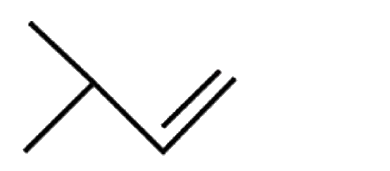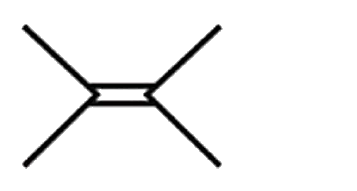CH3−CH2−CH∣Br−CH3alc.KOH−−−−→ΔX (Major)



None of these
The correct Answer is:A
To solve the given question, we need to identify the major product formed when the specified alkyl halide reacts with alcoholic KOH. Let's break down the steps involved in this reaction:
Step 1: Identify the Reactant
The reactant is an alkyl halide represented as:
CH3−CH2−CH(Br)−CH3
This structure indicates that we have a butyl bromide (specifically, 2-bromobutane).
Step 2: Understand the Reaction Conditions
The reaction is carried out with alcoholic KOH, which is a strong base. This suggests that the reaction will proceed via an elimination mechanism (E2 mechanism) to form an alkene.
Step 3: Mechanism of Elimination
In an elimination reaction, the halogen (Br) will be removed along with a hydrogen atom from a neighboring carbon. This process will lead to the formation of a double bond between the two carbons.
Step 4: Identify Possible Elimination Pathways
1. Elimination from Carbon 2 (where Br is attached):
- Removing Br and a hydrogen from Carbon 3:
CH3−CH=CH−CH3
This product is 2-butene.
2. Elimination from Carbon 3:
- Removing Br and a hydrogen from Carbon 2:
CH3−CH2−CH=CH2
This product is 1-butene.
Step 5: Determine Major Product Using Zaitsev's Rule
According to Zaitsev's rule, the more substituted alkene is favored as the major product. In this case:
- 2-butene (from the first elimination) is more substituted (it has 3 alkyl groups attached to the double bond).
- 1-butene (from the second elimination) is less substituted (it has only 1 alkyl group attached to the double bond).
Conclusion
The major product (X) formed from the reaction of the given alkyl halide with alcoholic KOH is:
X=CH3−CH=CH−CH3 (2-butene)
The reactant is an alkyl halide represented as:
CH3−CH2−CH(Br)−CH3
This structure indicates that we have a butyl bromide (specifically, 2-bromobutane).
The reaction is carried out with alcoholic KOH, which is a strong base. This suggests that the reaction will proceed via an elimination mechanism (E2 mechanism) to form an alkene.
In an elimination reaction, the halogen (Br) will be removed along with a hydrogen atom from a neighboring carbon. This process will lead to the formation of a double bond between the two carbons.
1. Elimination from Carbon 2 (where Br is attached):
- Removing Br and a hydrogen from Carbon 3:
CH3−CH=CH−CH3
This product is 2-butene.
- Removing Br and a hydrogen from Carbon 2:
CH3−CH2−CH=CH2
This product is 1-butene.
According to Zaitsev's rule, the more substituted alkene is favored as the major product. In this case:
- 2-butene (from the first elimination) is more substituted (it has 3 alkyl groups attached to the double bond).
- 1-butene (from the second elimination) is less substituted (it has only 1 alkyl group attached to the double bond).
The major product (X) formed from the reaction of the given alkyl halide with alcoholic KOH is:
X=CH3−CH=CH−CH3 (2-butene)
Topper's Solved these Questions
- ALKYI HALIDEBook:MOTIONChapter:ALKYI HALIDEExercise:Exercise - 4 | Level-I
Explore 18 Videos
- ALKYI HALIDEBook:MOTIONChapter:ALKYI HALIDEExercise:Exercise - 4 | Level-II
Explore 8 Videos
- ALKYI HALIDEBook:MOTIONChapter:ALKYI HALIDEExercise:Exercise -2 (Level-II) (Matrix Match)
Explore 6 Videos
- ALCOHOLS & ETHERSBook:MOTIONChapter:ALCOHOLS & ETHERSExercise:EXERCISE -4 (LEVEL -II) PREVIOUS YEAR JEE ADVANCED
Explore 9 Videos
- AROMATIC COMPOUNDBook:MOTIONChapter:AROMATIC COMPOUNDExercise:Exercise - 4 | Level-II
Explore 16 Videos
Similar Questions
In how many of the following reactions regioselectivity can be observed.
(I). CH3−CH3∣CH−CH2−Ohcon H2SO4−−−−−−−→Δ
(II). CH3−CH2−CH2−C∣OHH2Al2O3−−−→Δ
(III). CH3−CH3∣C−CH2−CH2−CH3alc.KOH−−−−−→Δ
(IV). CH3−CH2−C∣BrH−CH2−CH3Alc.KOH−−−−−→Δ
View SolutionIdentify the major product in the following reactions :
C6H5−CH2−H∣C∣Br−CH3Alc.KOH−−−−−→Δ?HBr−−→ ?
View Solution
Knowledge Check
CH3−CH2−CH∣Br−CH3alc.KOH−−−−→
XMajor , CH3−CH2CH∣NMe3⊕−CH3
EtONa−−−→ΔYMajor
Product (X) and (Y) respectively isA1-butene, trans-2-buteneB1-butene, cis-2-buteneCcis-2-butene, 1-buteneDtrans-2-butene, 1-buteneCH3−CH3∣C∣CH3−C∣BrH−CH3El mechanism−−−−−−−−−−→Δ(A)
Major product (A) isA B
B C
C D
D
Which of the following reactions will give the major and minor products?
CH3−CH2CH∣Br−CH3alc.KOH−−−−−→heatCH3−CH=CH(A)+CH3−CH2−CH=CH2(B)A(A) is major product and (B) is minor product.B(A) is minor product and (B) is major product.CBoth (A) and (B) are major products.DOnly (B) is formed and (A) is not formed.
Identify A and B
CH3−CH2−CH∣Br−CH3Alcoholic KOH−−−−−−−−→ΔA+B+2KBr+2H2O
View SolutionCH3CH2CH∣BrCH2CH=CH2alcoholic KOH−−−−−−−−→A (predominant) A is
View SolutionCH3−CH3∣C∣CH3−C∣BrH−CH3nderset(Δ)EtOH−−−→(A)
Major product (A) is:
View SolutionCH3−C∣ClH−C∣ClH−CH3(i)Alc.KOH−−−−−−−−−−→(ii)NaNH2A (major) H2−−−−−−−→Pd/CaCO3B
View SolutionConsider the following reactions:
CH3∣Br−CH2∣BrNaOH−−−−→H2O,ΔANaH−−→B,B+CH2∣Br−CH2∣Br→C
The major product formed is:
View Solution

